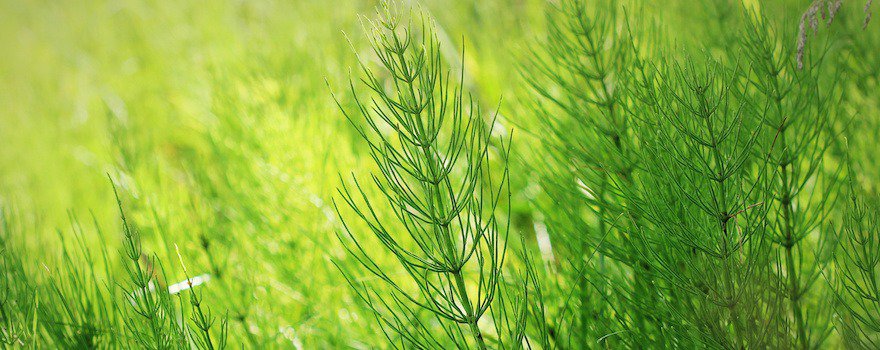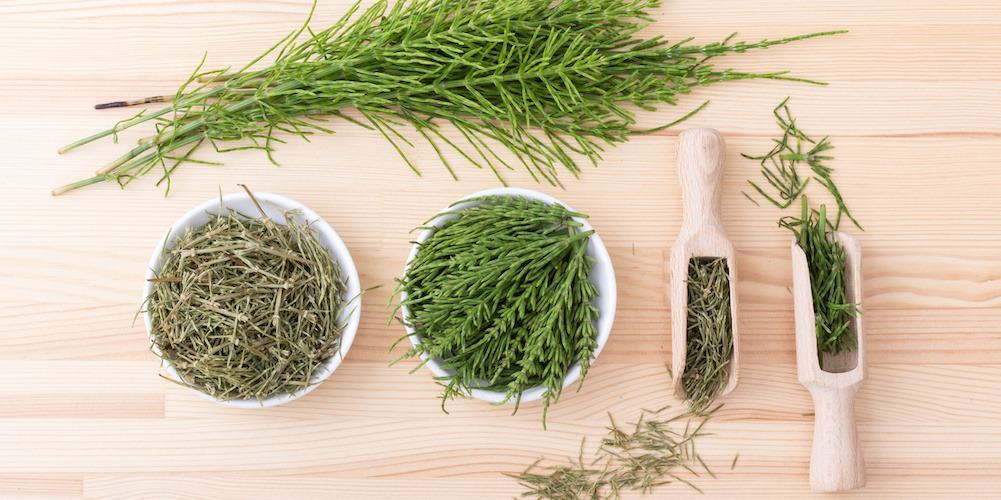What is horsetail?
Like the nettle, horsetail (Equisetum arvense) is a common plant in our regions. It is found in Europe but also in North Africa, America and Asia.
Also called « field horsetail », it is nicknamed « horse’s tail » or « rat’s tail » because of its appearance.
This plant belongs to the family Equisetaceae, one of the oldest botanical genera in the world. It is used in many traditional medicines because of its many benefits.
Only the sterile stems are consumed. They contain many minerals and trace elements, including silica.
They are also rich in antioxidants and in vitamin C. Horsetail is mainly known for its diuretic action on the body. Studies also show that it supports bone health, enhances skin appearance, and helps with diabetes. Finally, it is potentially anti-cancer.

Nutritional composition
- Acides aminés
- Vitamines : B1, C, E
- Minéraux et oligo-éléments : soufre, magnésium, silicium, sélénium, calcium, fer, manganèse, phosphore, potassium, zinc, chrome
- Protéines
- Fibres
- Acides gras
- Actifs antioxydants : flavonoïdes, saponines, tanins
- Acides organiques : acide ascorbique, férulique, malique, caféique, gallique, pectique, tannique
Benefits of horsetail
💦 Diuretic
Like the ginger and the kale, horsetail is a natural diuretic. Thus, it promotes the elimination of waste from the body. It enables better removal of these through urine and supports kidney function.
This plant is therefore useful for clearing the body of toxins and other toxic substances: medications, heavy metals…
By stimulating urine production, it can also relieve benign urinary disorders. It has been shown to be beneficial in the treatment of urinary stones, cystitis and renal colic (increased pressure in the ureters).
This review from Unilever’s Institute for Food and Health (Netherlands) shows the diuretic potential of Equisetum species.
🦴 Supports bone health
Depending on the harvest season, horsetail can contain up to 60 g of silica per 100 g (in November). This trace element is naturally present in bones, muscles, tendons and cartilage. It is therefore essential for bone health and well-being.
The plant exerts a remineralizing effect. It helps calcium bind more easily and promotes bone regeneration. Thus, it speeds up healing in the event of a fracture.
At the same time, it is anti-inflammatory. It helps reduce inflammation and pain related to osteoarthritis or osteoporosis.
This study from Zhengzhou University (China), conducted in patients with rheumatoid arthritis, shows the benefits of horsetail on the disease.
🍑 Enhances skin beauty
Silica also contributes to the beauty and health of the skin. It notably promotes collagen production and stimulates cell renewal. In addition, it contributes to the elasticity and suppleness of tissues. Its benefits also extend to nails and hair.
Horsetail has healing and regenerative properties. Thus, it is indicated to accelerate the healing of damaged tissues and minor wounds.
This study from Tabriz University of Medical Sciences (Iran), conducted in women, shows the healing effect of horsetail.
🍭 Helps with diabetes
By reducing blood sugar levels, it allows better diabetes control. At the same time, it promotes regeneration of the pancreas, the organ responsible for producing insulin.
But beware: its action is such that it can cause hypoglycemia. People with diabetes should therefore seek advice from their doctor before consuming it.
This study from Urmia University (Iran), conducted on rats, shows the antidiabetic effect of horsetail.
🔬 Potentially anti-cancer
Thanks to its antioxidant activity, it can reduce the proliferation of cancer cells. In addition, it induces apoptosis (programmed cell death). It has shown promise in the treatment of pancreatic cancer.
This study from the Baramulla Medical College (India), conducted on human cell lines, shows the anticancer potential of horsetail.

How to consume horsetail?
Horsetail in capsules
The capsules contain horsetail powder. This format is convenient, easy to take and above all tasteless. It is therefore ideal if you do not enjoy the slightly bitter flavor of the powder. These capsules are easy to find in stores, specialty shops, or online.
They should be sufficiently concentrated in silica (standardized to at least 5%). Also opt for plant-based capsules.
Horsetail powder
Once harvested, the sterile stems of the plant are dried and then finely ground. This yields a green powder to use in cooking and cosmetics.
The powder mixes easily into a glass of water, a fruit juice, or a smoothie. You can also add it to yogurt, a soup, or sprinkle it over a salad. Its taste is not unpleasant but slightly bitter.
Finally, it is ideal for formulating homemade care and cosmetics: hair masks, dry shampoos, creams, poultices…
Dried horsetail
The dried stems can be used to prepare horsetail decoctions. Steep 2 g of dried plant in 150 ml of boiling water. Let sit for 10 minutes. Strain and sweeten with honey or lucuma powder lucuma.
You can enjoy this drink at any time of the day.
Horsetail mother tincture
The mother tincture results from a hydroalcoholic extraction of the fresh stems of the plant. It is rich in silica but contains alcohol. Therefore, this form is not recommended for pregnant women, children, or people suffering from certain medical conditions.

Sustainable consumption: favor organic, local, and fair-trade horsetail
✓ It is possible to harvest horsetail in the wild. It grows in many regions of France. Look for it in wet and shaded areas, meadows, along paths and streams. Preferably harvest it in the fall: this is when its silica content is highest.
✓ Many French producers also cultivate horsetail. Favor French-grown crops and organic farming. There are also fair-trade channels that support the work of small producers.
Dosage
The recommended dosage is 2 g of horsetail per day.
Avoid consuming it for more than 4 consecutive weeks.
Contraindications and side effects
Consumption of horsetail has some contraindications:
- Par mesure de précaution, elle est déconseillée aux femmes enceintes et allaitantes et aux jeunes enfants ;
- Les personnes souffrant de troubles rénaux ou de problèmes cardiaques doivent éviter d’en consommer ;
- Sa consommation peut interagir avec les médicaments diurétiques ou de la famille de la digitaline. Demandez conseil à votre médecin si vous suivez un traitement ;
- Parce qu’elle peut entraîner une perte de potassium, elle est déconseillée chez les personnes présentant une hypokaliémie.
Consumption of horsetail has some side effects :
- Troubles digestifs
- Réaction cutanée
- Dermatite séborrhéique
If you experience side effects, stop taking it and consult a doctor.
Sources and scientific studies
C I Wright, L Van-Buren, C I Kroner, M M G Koning, 2007, Herbal medicines as diuretics: a review of the scientific evidence.
Xin Jiang, Qingshan Qu, Ming Li, Shuzhai Miao, Xing Li, Wenli Cai, 2014, Horsetail mixture on rheumatoid arthritis and its regulation on TNF-α and IL-10.
Azam Asgharikhatooni, Soheila Bani, Shirin Hasanpoor, Sakineh Mohammad Alizade, Yousef Javadzadeh, 2015. The effect of equisetum arvense (horse tail) ointment on wound healing and pain intensity after episiotomy: a randomized placebo-controlled trial.
Soleimani Safiyeh, Fathiazar Baijani Fathallah, Nejati Vahid, Nazemiyeh Hossine, Shojaei Sadee Habib, 2007. Antidiabetic effect of Equisetum arvense L. (Equisetaceae) in streptozotocin-induced diabetes in male rats.
Ajaz Ali Bhat, Bilal Ahamad, Muneeb U Rehman, Parvaiz Ahmad, 2020. Impact of ethanolic extract of Equisetum arvense (EA1) on pancreatic carcinoma AsPC-1 cells



